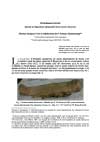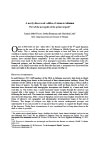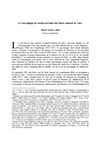Akhmim
« Doublement Ă©ternel. Quand les Egyptiens inhumaient leurs morts deux fois »
ENiM 7, 2014, p. 61-78.
 Le musĂ©e dĂ©partemental des AntiquitĂ©s Ă Rouen conserve une momie dâenfant (ĂągĂ© de 2-3 ans) dĂ©couverte en 1889 Ă AkhmĂźm par G. le Breton alors directeur et conservateur du musĂ©e. Si lâapparence extĂ©rieure de cette momie est tout Ă fait classique, lâexamen radiographique indique que la tĂȘte est en fait maintenue au corps par une tige de palmier (gerid). Dâautres momies prĂ©sentent une telle particularitĂ© interprĂ©tĂ©e le plus souvent comme le tĂ©moignage dâune momification de piĂštre qualitĂ©. Il apparaĂźt que la dislocation de la tĂȘte ne peut raisonnablement se produire lors des opĂ©rations de momification, mais semble plus logique si elle intervient longtemps aprĂšs la mort. DĂšs lors, la tige de palmier sert Ă assurer au dĂ©funt son unitĂ© corporelle, un des principaux concepts de la pensĂ©e funĂ©raire Ă©gyptienne. Le gerid tĂ©moigne dâun type d'intervention aprĂšs inhumation diffĂ©rent de ceux mis en Ă©vidence dans la NĂ©cropolis dâAlexandrie. Cela signifie Ă©galement que lâemmaillotage actuellement visible n'est pas lâoriginal puisque la momie a dĂ» ĂȘtre bandelettĂ©e Ă nouveau aprĂšs la resolidarisation de la tĂȘte au corps.
Le musĂ©e dĂ©partemental des AntiquitĂ©s Ă Rouen conserve une momie dâenfant (ĂągĂ© de 2-3 ans) dĂ©couverte en 1889 Ă AkhmĂźm par G. le Breton alors directeur et conservateur du musĂ©e. Si lâapparence extĂ©rieure de cette momie est tout Ă fait classique, lâexamen radiographique indique que la tĂȘte est en fait maintenue au corps par une tige de palmier (gerid). Dâautres momies prĂ©sentent une telle particularitĂ© interprĂ©tĂ©e le plus souvent comme le tĂ©moignage dâune momification de piĂštre qualitĂ©. Il apparaĂźt que la dislocation de la tĂȘte ne peut raisonnablement se produire lors des opĂ©rations de momification, mais semble plus logique si elle intervient longtemps aprĂšs la mort. DĂšs lors, la tige de palmier sert Ă assurer au dĂ©funt son unitĂ© corporelle, un des principaux concepts de la pensĂ©e funĂ©raire Ă©gyptienne. Le gerid tĂ©moigne dâun type d'intervention aprĂšs inhumation diffĂ©rent de ceux mis en Ă©vidence dans la NĂ©cropolis dâAlexandrie. Cela signifie Ă©galement que lâemmaillotage actuellement visible n'est pas lâoriginal puisque la momie a dĂ» ĂȘtre bandelettĂ©e Ă nouveau aprĂšs la resolidarisation de la tĂȘte au corps.
 In the musée des Antiquités in Rouen, one can see a child mummy (2-3 years of age) discovered in 1889 in Akhmim by G. Le Breton who was at that time the director of the museum. It has the classical external appearance of a mummy, but x-Rays examination shows that the head is joined to the body with a piece of palm stalck (gerid). Several mummies present such a characteristic which is very often interpreted in terms of poor quality mumification. But it appears that such a fracture cannot occur during the mumification process, but, on the contrary, can occur a long-time after death. The fracture was repaired using a stick to guarantee the body unity of the deceased, one of the most important concepts of the Egyptian Afterlife. This gerid is a testimony of a post-burial intervention different from what can be done in the Necropolis of Alexandria. It also means that the mummy bandaging is not the original one as the mummy needed to be wrapped an other time after the head was replaced onto the body.
In the musée des Antiquités in Rouen, one can see a child mummy (2-3 years of age) discovered in 1889 in Akhmim by G. Le Breton who was at that time the director of the museum. It has the classical external appearance of a mummy, but x-Rays examination shows that the head is joined to the body with a piece of palm stalck (gerid). Several mummies present such a characteristic which is very often interpreted in terms of poor quality mumification. But it appears that such a fracture cannot occur during the mumification process, but, on the contrary, can occur a long-time after death. The fracture was repaired using a stick to guarantee the body unity of the deceased, one of the most important concepts of the Egyptian Afterlife. This gerid is a testimony of a post-burial intervention different from what can be done in the Necropolis of Alexandria. It also means that the mummy bandaging is not the original one as the mummy needed to be wrapped an other time after the head was replaced onto the body.
 Consulter cet article (56519) -
Consulter cet article (56519) -  Télécharger cet article au format pdf (28728)
Télécharger cet article au format pdf (28728)
« A newly discovered edifice of Atum in Akhmim. Part of the necropolis of the primeval gods? »
ENiM 8, 2015, p. 187-221.
 Dans le voisinage immĂ©diat de lâinspectorat dâAkhmĂźm un bĂątiment de lâĂ©poque ptolĂ©maĂŻque dĂ©diĂ© au dieu Atoum a Ă©tĂ© dĂ©couvert Ă une profondeur dâenviron 5 mĂštres sous une maison Ă lâoccasion dâune fouille clandestine. Il sâagit dâune porte dĂ©corĂ©e mais non datĂ©e, les cartouches Ă©tant restĂ©s vides. Atoum est quatre fois reprĂ©sentĂ© comme serpent et une fois avec une tĂȘte du faucon. Atoum Ă©tant caractĂ©risĂ© sur ces montants de porte comme un dieu primordial, il est possible que ce monument ait fait partie de la nĂ©cropole des dieux ancĂȘtres.
Dans le voisinage immĂ©diat de lâinspectorat dâAkhmĂźm un bĂątiment de lâĂ©poque ptolĂ©maĂŻque dĂ©diĂ© au dieu Atoum a Ă©tĂ© dĂ©couvert Ă une profondeur dâenviron 5 mĂštres sous une maison Ă lâoccasion dâune fouille clandestine. Il sâagit dâune porte dĂ©corĂ©e mais non datĂ©e, les cartouches Ă©tant restĂ©s vides. Atoum est quatre fois reprĂ©sentĂ© comme serpent et une fois avec une tĂȘte du faucon. Atoum Ă©tant caractĂ©risĂ© sur ces montants de porte comme un dieu primordial, il est possible que ce monument ait fait partie de la nĂ©cropole des dieux ancĂȘtres.
 A doorway recently discovered at the slope of the historic centre of Akhmim may be part of a chapel dedicated to Akhmim in the so-called necropolis of primeval gods and at the same time may also be an oracle site of the snake-shaped god Atum. Two texts inscribed in the temple of Athribis, 15 km to the southwest, likely refer to this district too. If this interpretation is correct, these texts mention the names of two buildings that would be part of that district. The first would be iAt Mnw: âthe hill of Minâ designating the sacred hill (iAt nTryt) and the second would be TpHt-Axt referring to the tomb of Osiris. The names of the sacred snake would be Atum xns iAwt and anx-HH: âthe one with living Heh figureâ, as indicated by the text in Athribis. Moreover, this text provides the names of two sacred trees: the kbs (= ksbt)-tree and the arw-tree â neither of which can be securely identified. Nevertheless, the relation between the ksbt-tree and Min of Koptos is attested since the Middle Kingdom. It is desirable to carry out scientific excavations in Akhmim to confirm or reject the assumptions mentioned in this article. However, this will not be an easy task to realize in the near future.
A doorway recently discovered at the slope of the historic centre of Akhmim may be part of a chapel dedicated to Akhmim in the so-called necropolis of primeval gods and at the same time may also be an oracle site of the snake-shaped god Atum. Two texts inscribed in the temple of Athribis, 15 km to the southwest, likely refer to this district too. If this interpretation is correct, these texts mention the names of two buildings that would be part of that district. The first would be iAt Mnw: âthe hill of Minâ designating the sacred hill (iAt nTryt) and the second would be TpHt-Axt referring to the tomb of Osiris. The names of the sacred snake would be Atum xns iAwt and anx-HH: âthe one with living Heh figureâ, as indicated by the text in Athribis. Moreover, this text provides the names of two sacred trees: the kbs (= ksbt)-tree and the arw-tree â neither of which can be securely identified. Nevertheless, the relation between the ksbt-tree and Min of Koptos is attested since the Middle Kingdom. It is desirable to carry out scientific excavations in Akhmim to confirm or reject the assumptions mentioned in this article. However, this will not be an easy task to realize in the near future.
 Consulter cet article (48264) -
Consulter cet article (48264) -  Télécharger cet article au format pdf (25688)
Télécharger cet article au format pdf (25688)
« Le Sarcophage de Setsha-iret-binet du MusĂ©e-chĂąteau de VitrĂ© »
ENiM 18, 2025, p. 107-124.
 Depuis 1953, le chĂąteau-musĂ©e de VitrĂ© (Ille-et-Vilaine) conserve dans ses rĂ©serves un sarcophage Ă©gyptien dâĂ©poque ptolĂ©maĂŻque (332-30 av. J.-C.) provenant de la nĂ©cropole dâAkhmĂźm. GrĂące Ă de nouvelles recherches et Ă©tudes, nous avons pu en dĂ©terminer lâorigine exacte : Ipou / AkhmĂźm, et sa propriĂ©taire : Setsha-iret-binet. LâĂ©tude prĂ©sentĂ©e ici donne les rĂ©sultats des investigations et des diverses analyses effectuĂ©es sur ce magnifique objet.
Depuis 1953, le chĂąteau-musĂ©e de VitrĂ© (Ille-et-Vilaine) conserve dans ses rĂ©serves un sarcophage Ă©gyptien dâĂ©poque ptolĂ©maĂŻque (332-30 av. J.-C.) provenant de la nĂ©cropole dâAkhmĂźm. GrĂące Ă de nouvelles recherches et Ă©tudes, nous avons pu en dĂ©terminer lâorigine exacte : Ipou / AkhmĂźm, et sa propriĂ©taire : Setsha-iret-binet. LâĂ©tude prĂ©sentĂ©e ici donne les rĂ©sultats des investigations et des diverses analyses effectuĂ©es sur ce magnifique objet.
 Since 1953, the Vitré castle-museum (Ille-et-Vilaine) has kept in its reserves an Egyptian sarcophagus from the Ptolemaic period (332-30 BC) from the Akhmßm necropolis. Thanks to new research and studies, we were able to determine the exact origin: Ipou / Akhmßm, and its owner: Setsha-iret-binet. The study presented here gives the results of the investigations and various analyzes carried out on this magnificent object.
Since 1953, the Vitré castle-museum (Ille-et-Vilaine) has kept in its reserves an Egyptian sarcophagus from the Ptolemaic period (332-30 BC) from the Akhmßm necropolis. Thanks to new research and studies, we were able to determine the exact origin: Ipou / Akhmßm, and its owner: Setsha-iret-binet. The study presented here gives the results of the investigations and various analyzes carried out on this magnificent object.
 Consulter cet article (4118) -
Consulter cet article (4118) -  Télécharger cet article au format pdf (1318)
Télécharger cet article au format pdf (1318)
ENiM 18 - 2025
8 article(s) - 8 octobre 2025.
ENiM 1 à 18 (2008-2025) : 227 articles
5 292 302 téléchargements
10 559 231 consulations.
Index des auteurs

Mots clés

Derniers articles : 
CENiM - Mise en ligne des volumes Ă©puisĂ©s : 
 Anne-Sophie von BOMHARD DĂ©cans Ă©gyptiens, CENiM 23, Montpellier, 2020 — (2020)
Anne-Sophie von BOMHARD DĂ©cans Ă©gyptiens, CENiM 23, Montpellier, 2020 — (2020) 
 Jean-Claude Grenier L'Osiris ANTINOOS, CENiM 1, Montpellier, 2008 — (26 dĂ©cembre 2008)
Jean-Claude Grenier L'Osiris ANTINOOS, CENiM 1, Montpellier, 2008 — (26 dĂ©cembre 2008) 
TDENiM - Mise en ligne des volumes Ă©puisĂ©s : 
 Twitter
Twitter 4207671 visites - 8092 visite(s) aujourd’hui - 92 connecté(s)
© ENiM - Une revue d’égyptologie sur internet
Équipe Égypte Nilotique et Méditerranéenne - UMR 5140 - « Archéologie des Sociétés Méditerranéennes » (Cnrs) - Université Paul Valéry - Montpellier III
























 Contact
Contact
 Abonnez-vous !
Abonnez-vous ! Équipe Égypte Nilotique et Méditerranéenne
Équipe Égypte Nilotique et Méditerranéenne UMR 5140 « Archéologie des Sociétés Méditerranéennes » (Cnrs)
UMR 5140 « Archéologie des Sociétés Méditerranéennes » (Cnrs) Université Paul Valéry - Montpellier III
Université Paul Valéry - Montpellier III